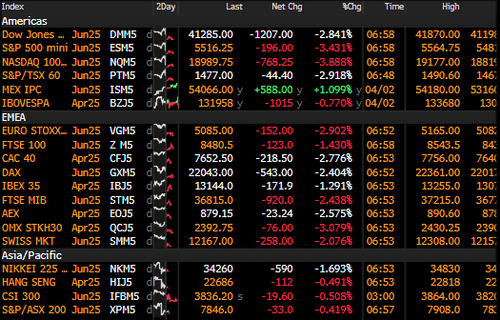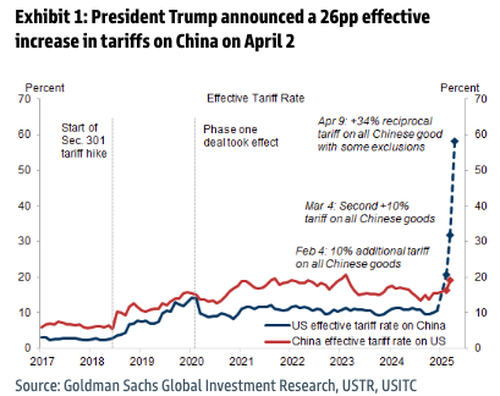
Beijing Slams Trump’s „Unilateral Bullying” Tariffs, Signals Retaliatory Action
President Trump’s late afternoon announcement on Wednesday—”Liberation Day”—unveiled a far more aggressive tariff policy than top Wall Street analysts had anticipated, prompting panic dumping in global equities and futures markets overnight.

Of particular concern is Trump’s stance toward China. The total effective tariff rate on Chinese imports surged to 54%, a dramatic increase of 34% from the previously imposed 20% in additional levies tied to fentanyl and earlier duties.

Trump’s Liberation Day has drawn swift condemnation from Beijing, which has described the escalating tariff war as „unilateral bullying.”
Nikkei Asia quoted China’s Ministry of Commerce, warning that it „firmly opposes” Trump’s tariffs and „will resolutely take countermeasures to safeguard its own rights and interests.”
The Commerce Ministry noted that the US „ignored” the benefits of a global trading system, adding, „The so-called 'reciprocal tariffs,’ which are based on subjective and unilateral assessments by the United States, are not in line with the rules of international trade, seriously jeopardize the legitimate rights and interests of the parties concerned, and are typical of unilateral bullying.”
The ministry did not discuss specifics on the countermeasures. A ministry spokesperson told reporters that Beijing hopes to „resolve various issues through equal consultation.”
In other words, it’s just a matter of time before Beijing mounts a countermeasure against the US, whether that’s targeted tariffs, export controls, or other measures (such as targeting US Big Tech). Or as we’ve recently seen: Beijing Derailing Panama Port Deal.
Guo Jiakun, a spokesperson for China’s Ministry of Foreign Affairs, sang the same tune: China „firmly opposes” Trump’s trade war escalation, which „seriously undermines” the rules-based global trading system. He urged Washington to resolve trade differences through talks.
However, President Trump tried that with the Chinese Communist Party in his first term with the so-called „Phase One” agreement. Beijing committed to purchasing $200 billion of additional US exports. Yet, the phase one deal with the CCP was derailed by Covid disruptions.
The Trump administration’s goal with reciprocal tariffs against literally the entire world, including some cases of near triple-digit reciprocal tariffs that will lead to a historic emerging markets shock, is to reverse a half-century or more of de-industrialization policies in the US that have hollowed out the nation’s core and produced a national security threat as the world fractures into a bipolar state.
pic.twitter.com/fSHTQWcauf
— Crypto_Maximaliste (@Crypto__Maxi) April 2, 2025
In financial markets, the People’s Bank of China set the daily reference rate for the yuan at 7.1889 per dollar, weakening the currency. This allows the yuan to depreciate and support export competitiveness. A move like this will only draw accusations of currency manipulation from Trump.
„We maintain our view that the PBOC will not allow a sharp [yuan] depreciation given capital outflow risks and the government’s objective to restore confidence in the Chinese economy,” HK Mizuho Securities analyst Ken Cheung wrote in a note earlier.
Goldman analysts Andrew Tilton and others told clients:
On April 2, President Trump announced „reciprocal” tariffs on trading partners with exclusion of products that are subject to sectoral tariffs, resulting in what we estimate to be an increase of 26pp in the average effective US tariff rate on China, which would bring the total effective tariff rate on Chinese goods to 58%.
This is much higher than we and the market had expected. Similar to the experience when the previous two 10% tariff increases were imposed on China earlier this year, we think the Chinese government is likely to retaliate with some targeted tariffs on US products as well as non-tariff measures like export controls.
We expect policymakers to continue to resist significant CNY depreciation. We believe the government will step up easing measures to offset the additional growth drag from higher tariffs. We are not changing our 2025 full-year GDP growth forecast of 4.5% at this time due to better-than-expected Q1 data and increased policy easing expectations, as well as remaining uncertainties regarding whether some of the tariffs could be negotiated down in the coming months. That said, we acknowledge downside risk from slowing global growth after the large, across-the board US tariff increases.
S&P Global Ratings credit analyst Ming Tan warned that Trump’s tariffs could exacerbate China’s weak economy:
„The drag on China’s economy from higher tariffs will transmit to banks. We expect problem loans will rise over the next few years and could leap as high as 6.4% of total loans in a downside scenario.”
Fred Neumann, chief Asia economist at HSBC, had a big-picture view for clients: „The era of Asia’s export manufacturing-led development has come to an end, and the region will need to develop markets closer to home.”
Tyler Durden
Thu, 04/03/2025 – 07:20
